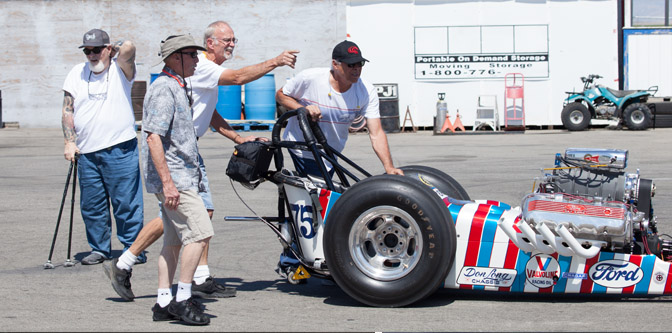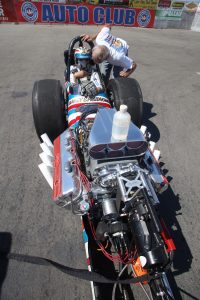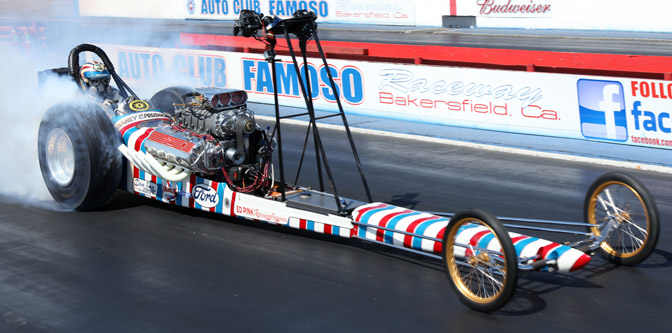Vanishing History and the Anatomy of a Cover Shoot

“Photographers deal in things which are continually vanishing and when they have vanished there is no contrivance on earth which can make them come back again” — Henri Cartier-Bresson
Henri Cartier-Bresson was an influential French photographer who championed the idea of the decisive moment. He captured these moments, some big, some small, on film countless times in thousands of places up until he passed away at the age of 95. From his portraits to his street photography, he was responsible for some of the 20th century’s most striking, honest images that I’m sure many of you have seen before. I’ve long been a fan of his work.
Mr. Cartier-Bresson wasn’t a hot rodder, chassis fabricator or engine builder. He didn’t drive a ’32 Ford highboy or race a streamliner at Bonneville. He did photograph some European racecars at one point, but as far as I can tell he never attended a car show, drag race or even read a car magazine. All that didn’t seem to matter, because as soon as I heard that we were going to shoot Don Prudhomme’s “Shelby Super Snake” in action for the cover of The Rodder’s Journal, I thought back to that lecture hall in mid-Missouri where I took notes on a Power Point presentation (and video supplement) about Henri Cartier-Bresson. It was during that lesson that I first came across the epigraph that’s italicized at the top of this article.
I like how the Shelby Super Snake story challenges Cartier-Bresson’s quote. Actually, the car even existing (and running) today does in its own strange way. The ’60s may have ended a long time ago, but we didn’t care. We were determined to relive a moment from our hobby’s history that had long since vanished—Don Prudhomme smoking the tires in the Super Snake dragster. Not only did we want to recreate the scene, we wanted to capture it just like Bob Swaim did for Car Craft close to 50 years ago: overhead, in the smoke with Cammer roaring and the Snake at the controls.
The Plan
This whole thing started last spring with a ringing phone at The Rodder’s Journal’s South San Francisco headquarters. Don Prudhomme was on the other end and he meant business. Now retired from racing, he was wrapping up the restoration on his Shelby Super Snake AA/Fuel Dragster and he was wondering if we wanted to feature it. Editor Geoff Miles and publisher Steve Coonan gave it some thought and, after checking the perpetually overloaded schedule, worked out a way to fit the red, white and blue striped slingshot into the upcoming TRJ #72. (Disclaimer: If you’re looking to get your car featured in the magazine this is not the best approach. Instead, shoot us an email at [email protected].)
Before we move any further, let’s briefly talk about the car itself. Back in 1967, the Shelby Super Snake was a dominant force in the Fuel Dragster ranks. It was the brainchild of longtime hot rodder Lou Baney, who, in a quest for lower e.t.s, wrangled up the sport’s top talent to put together a powerhouse team. Don Long engineered the chassis, Ed Pink built the Cammer and, after firing Tom “The Mongoose” McEwen, Don Prudhomme found a home behind the butterfly wheel. The Super Snake set national records, was the first in the sixes, won major races and left a lasting impression on the sport of drag racing. Over the past two-and-a-half years, Prudhomme worked with the original crew to bring the car back to life. That’s the painfully short version of the story.
With the feature penciled into the spreadsheet, we dialed in the logistics at TRJ. For weeks Geoff and Steve were constantly on the phone ordering camera equipment and talking with tech support people who really had no idea what type of project we were taking on. Magneto? Nitro? Go-Pros? Film? Digital? Remote triggers? Yes. All of the above. The first time around Don Long built the camera mount, which was a lightweight assembly (you could call it broomstick-esque) with minimal reinforcement and accommodations for Swaim’s motor drive Nikon. Since that one was long gone, we had Prudhomme fabricate a new bracket to mount three of our cameras: digital, film and video.
When it came to booking the track, we looked for a semi-central location between our San Francisco office and Prudhomme’s shop down near San Diego. Auto Club Famoso Raceway in Bakersfield was a natural choice. Prudhomme won his first professional race there in March of 1962, and it would serve as an excellent backdrop for the Fueler’s first burnout in close to half a century.
While the pieces continued falling into place, I was called into Steve’s office to talk about story assignments for the issue. After some discussion, the Super Snake article landed on my plate and I immediately scribbled the particulars in my then-new legal notepad. Start Date: June 8, 2016. Due Date: July 22, 2016. And across the top of the page, among the columns of bulleted lists and critical magazine features, I wrote the most important piece of information: Bakersfield, California—Tuesday, June 21st—10 a.m.-10 p.m. That’s when it’d all go down.
I spent the next few weeks with my desk stacked high with 1967 and 1968 Car Craft and Hot Rod binders, photocopied Don Long invoices and other crucial documents, taking notes on everything I could find from that era pertaining to Baney, Pink, Long and Prudhomme. It wasn’t long before I’d developed a stack of 3×5 index cards with bulleted information about each major player in the car’s history. (I’d keep them in my back pocket to reference whenever I was at the grocery store, out to dinner, etc.) Remember, I was interviewing the guys who lived it—there’s no way I was going to show up unprepared. My legal pad started to fill with names, dates, timelines and outlines. And then on the Tuesday after the L.A. Roadster Show, we were set to head for Bakersfield.
The Shoot
Whether or not we were ready soon became irrelevant as we eyed the weather forecast for the coming week. Temperatures in Bakersfield were slated to be somewhere north of 100, and as anyone who has ever been to a drag strip can attest, that’s pushing it. We weighed our options and got on the horn with Prudhomme. The choice was his: move forward with the shoot or reschedule for the fall. He didn’t think twice—he wanted to put that car through its paces, regardless of the climate. Just like that, we were on.
Due to some conflicting schedules, my brother Andrew and I planned to meet Steve, Geoff and the Prudhomme crew at the track the morning of the shoot. We had rented the track for most of the day, so they figured that with enough coordination, they could handle the cover shoot, low light and nighttime fire-up shots in that 12-ish hour window.
The events that transpired on June 21st on that strip of asphalt somewhere deep within the Southern California orchards seemed to happen quickly. Sure, there was a whole lot of downtime, but looking back, all the moments were filled with something. There was the burning sun and the dry air; the watering eyes and the eight pipes rapping, shaking me inside and out; the glint of the polished magnesium and the smell of rubber that had melted moments ago. Long conversations, short conversations, questions, answers—they were all there.
But the moment that stuck with me took place right in the middle of all this. Prudhomme had just finished his first burnout and we grabbed the memory cards from the various cameras (including the one mounted on a metal plate which had been baking in the 100-plus degree heat on the track for a couple of hours. Hot!) We climbed the wooden tower steps for the um-teenth time, stepped into the air conditioning and closed the door. Geoff put the memory card into the laptop.
Photos loaded. We waited.
He clicked.
An image appeared.
There was no question: we got the shot.
What we were looking at was the future cover of Rodder’s Journal #72, the one that’ll find its way from newsstands to bookshelves and coffee tables across the globe. It captures the action like Swaim’s Car Craft centerspread while incorporating a few changes of our own. I told myself that I wasn’t going to use the “I guess you have to read the story” line, but in my biassed opinion, I’d say that’s the best thing to do. We’re pretty excited with how it all turned out, and we hope you are too.
If you’re in Bakersfield for the 25th annual California Hot Rod Reunion this weekend, make sure to swing by The Rodder’s Journal tent and say hi. I’ve actually never been to this event, but from what I hear (and have read in magazines since I was 10 years old), it’s a complete sensory overload. Wish me luck out there, I think I’m gonna need it.
Best of all, Prudhomme’s Shelby Super Snake will be in and out of the booth throughout the weekend, so if you’re trying to get a closer look at that spectacular Don Long (“Gone Wrong” as he’s sometimes called) chassis, Ed Pink/Ed Pink’s Garage Cammer (“He built me a Rolex!” Snake says) or that (wild!) “Wild Bill” Carter paintjob, this is your chance.
Maybe things never can go back to the way they were, and maybe they don’t need to. It’s 2016 now, and we’re able to re-live the sixties—even if its for a brief moment—with the Shelby Super Snake.—Joey Ukrop
Photos by Steve Coonan, Geoff Miles and myself. Historic photo by Russ Griffith, courtesy of Frank Baney









